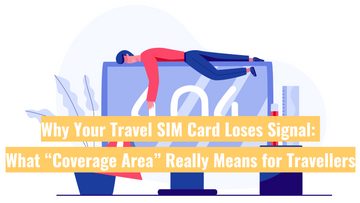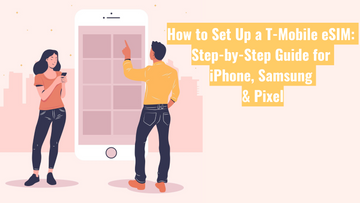Why Your Travel SIM Card Loses Signal: What “Coverage Area” Really Means for Travellers

Picture this: you’ve just landed in your dream destination — maybe the bustling streets of Bangkok, the wild Scottish Highlands, or a tiny island off the coast of Fiji. You whip out your phone to check Google Maps, but instead of the comforting full bars, you’re greeted with No Service. The panic sets in. How will you find your hotel? How will you translate that café menu, or make an emergency call if you need one?
If this sounds painfully familiar, you’re not alone. “Coverage” with your travel SIM or eSIM isn’t always as simple as the glossy brochures make it out to be. Even with “nationwide” coverage, you can still run into dead zones — and they’re not always your fault.
In this guide, you’ll learn why coverage issues happen, how to research them before you fly, and practical steps to stay connected — no matter where your next destination takes you.
Deconstructing “Coverage Area”: It’s More Than Just a Map
Let’s bust a myth: that neat, colourful coverage map you see on a provider’s website isn’t a magic guarantee you’ll have signal everywhere. Here’s why:
- Network Infrastructure: Mobile coverage depends on cell towers that broadcast different radio frequencies — 2G, 3G, 4G LTE, or 5G. If your phone or travel SIM isn’t compatible with a local network’s frequencies, you could find yourself stuck with painfully slow data or no signal at all.
- Density of Towers: Big cities are brimming with towers. That’s why you’ll usually have strong signal in urban areas. But head out to rural villages, mountainous regions, or remote islands and you’ll quickly see fewer towers covering much larger areas — patchy coverage is almost guaranteed.
- Terrain and Obstacles: Hills, thick forests, tall concrete buildings and tunnels can all block or weaken your signal, no matter how many towers are nearby.
- Network Roaming Agreements: Your travel SIM or eSIM relies on roaming partnerships with local carriers. So your actual connectivity depends on the local carrier’s network — and each carrier has its own strengths and blind spots.
- Popularity of the Network: Too many people using the same tower — like in busy tourist hotspots or stadiums — can overload it, leaving you with slow speeds or dropped connections, even if the coverage map says you’re covered.
Local Nuances: Coverage Gaps Happen Everywhere
It’s easy to assume that coverage will be perfect just because you’re near a popular destination — but the reality is, every country has its patchy spots.
For example, in Southeast Asia, you’ll find great connectivity in major cities like Jakarta, Bangkok, or Denpasar (Bali). But once you head into more remote areas — like North Sumatra’s highlands, the jungles of Borneo, or the smaller islands around Komodo National Park — your signal can drop out fast. The same holds true around the world: parts of the Scottish Highlands, the remote corners of New Zealand’s South Island, or the Australian outback all have notorious black spots.
If you’re planning adventures in far-flung regions — like island-hopping in the Philippines, exploring Patagonia, or diving in Raja Ampat — you may need to accept that mobile data won’t always be an option. In some truly remote spots, satellite phones or communication devices are the only reliable backup.
Common Scenarios Where Coverage Becomes an Issue for Travellers
- Remote Destinations: Hiking trails, national parks, mountain lodges, small islands or deserts often have minimal coverage.
- Underground or Indoors: Subways, deep basements, and massive shopping centres can block your signal entirely.
- Cruises and Ferries: Out at sea, you’ll either have no signal or rely on expensive satellite connections.
- Border Regions: Your phone might latch onto a stronger signal from a neighbouring country’s network, which can lead to unexpected roaming charges.
- Carrier Weak Spots: Even in major cities, one local network might have dead spots that another doesn’t.
Be Prepared: Offline Tools and Battery Back-Up
If there’s one golden rule, it’s this: always plan for the possibility of “No Signal” moments — especially if you’re travelling off the beaten track.
Your phone works harder searching for a signal in low-coverage areas, which drains your battery faster than you’d expect. Always pack a fully charged power bank so you’re not left stranded with a dead phone when you need it most.
Before heading into patchy zones, download:
- Offline maps (like Google Maps offline areas or Maps.me).
- Translation apps that work without a connection.
- Any essential booking details or travel documents.
A bit of pre-planning means you can keep navigating, communicating and finding your way — even when your signal drops out entirely.
Proactive Strategies: How to Research and Ensure Better Coverage
Here’s how to stack the odds in your favour before you set off with your travel SIM or eSIM:
- Check Coverage Maps (and Read the Fine Print): Visit local carrier websites for your destination — they’ll have the most up-to-date maps. Try tools like OpenSignal or CellMapper, which rely on real user data, and cross-check more than one source. Find out which local network your travel SIM uses, then research that carrier’s coverage.
- Read Recent Reviews: Look up travel forums and review sites for up-to-date reports about signal strength in the places you plan to visit.
- Ask Locals and Other Travellers: Reception staff at your accommodation or friendly locals often know exactly where the dead spots are.
- Consider a Dual SIM/eSIM Setup: If your phone supports it, keep a local pay-as-you-go SIM or eSIM from another carrier as a backup — especially useful for staying connected in an emergency.
Troubleshooting When You Lose Signal
You did your research, but you still lose signal? Try these quick fixes:
- Restart your phone.
- Toggle airplane mode on and off to force a network re-scan.
- Manually select a different network in your phone’s mobile settings (if your SIM allows it).
- Check that your APN settings match your provider’s instructions.
- Update your phone’s software.
- Move around — step outside, change floors or get away from tall obstacles.
- Contact your travel SIM or eSIM provider’s support team with details of your location if all else fails.
Final Thoughts
Staying connected while you travel is about more than picking the cheapest plan. It’s about understanding how real coverage works, being prepared for inevitable gaps, and having a plan B for when your connectivity drops.
Check coverage maps, read recent traveller reviews, and get your offline tools ready. That way, you can spend more time making memories and less time waving your phone around for a single bar of reception.












